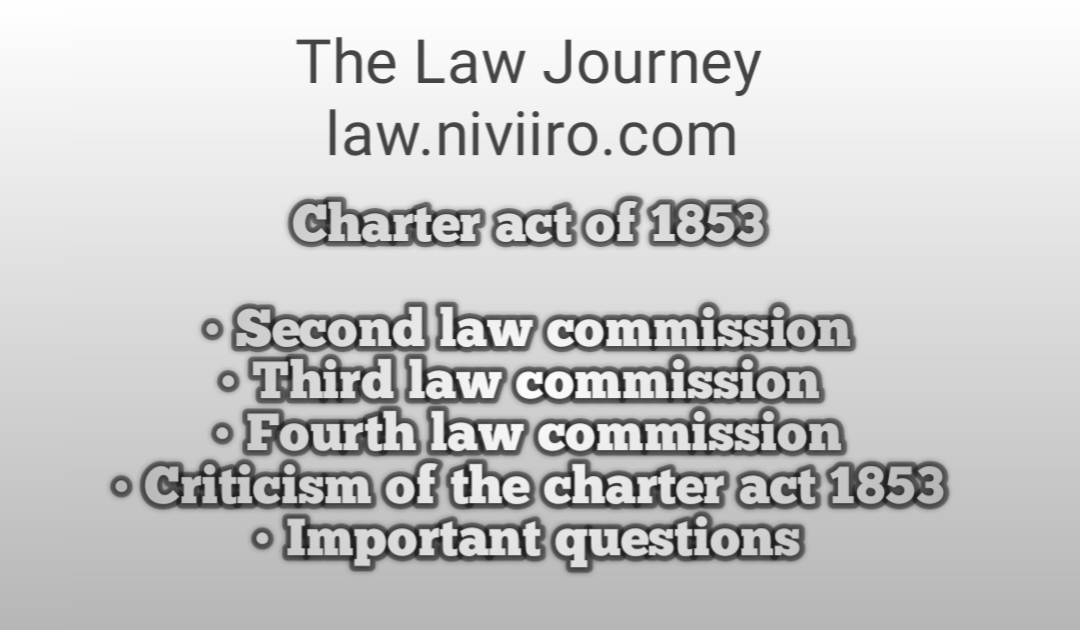The charter act of 1853 introdused second,third and fourth law commission which are as followings ;
Second Law Commission | Charter act of 1853
The second law commission was appointed on november 29, 1853 for a period of 3 years under the chairmanship of sir john romilly. There were seven members in law commission. This commission held its meeting in london till the middle of 1856 and submitted its 4 reports after examining proposals of the first law commission.
Reports: The second Law commission submitted four reports to the Indian Government. The first report was submitted in 1855, second, third and fourth reports were submitted in 1856.
First Report: In the first report, the commission submitted a plan for reforms in judiciary and in courts procedure.
Second Report: In its Second report the commission agreed with the lex-loci report of the first Law commission. It suggested that there must be a substantive civil law for persons in the mofussil who had no law of their own.
Third and Fourth Report: In these two reports, the commission submitted a plan for the amalgamation of the Supreme Court and Sadar courts and a uniform civil code of procedure and criminal procedure applicable both to the High Court’s to be formed by that amalgamation.
Codes proposed by second law commission –
The second law commission submitted four draft codes on civil procedure which were finally introduced as codified civil law under the act of 1859. This code was abolished in 1877 and 1882. Finally the civil procedure code of 1908 enforced throughout the country. The penal code drafted lord macauley in 1837 was revised by sir barnis peacock. Who was one of the members of the second law commission and finally enacted on 1860.
Third Law Commission | Charter act of 1853
The third law commission was appointed on december 14, 1861 under the chairmanship of sir john romilly. There were 6 members in this commission.
Function – the main function of the third law commission was to proceed with the codification of the substantive law in india as suggested by the second law commission in its second report.
The Third Law Commission submitted 7 reports containing the drafts of proposed laws to the Secretary of State for India.
First Report: the Commission prepared the draft of the law of succession and inheritance generally applicable to all classes of persons other than Hindus and Muslims, which was enacted as the India Succession Act, 1863.
Second Report: draft of the law of contracts in general including sale of movable property, indemnity and guarantee
Third Report: draft of the law of negotiable instruments, viz, promissory notes, bills of exchange and cheques
Fourth Report: reply to remarks and objections of Government of India in its draft law of contracts contained in its second report.
Fifth Report: draft of law of evidence
Sixth Report: draft of transfer of property
Seventh and last report: revision of the Criminal Procedure Code which had already been enacted into law in 1861.
Fourth Law Commission | Charter act of 1853
In 1875, lord salisburry, the secreatary of state for india wrote a letter to the government of india that under the provisions of the indian council act 1861. It was possible to appoint a law commission in india itself.
He suggested that a team of eminent draftmen could be intrusted the task of preparing the drafts of different branches of the indian law. The govt of india accepted the proposal and proposed certain laws to be considered for the codification.
They included trust, easement, master and servants, transfer of immoveable property and negotiable instruments. It proposed that codification of these laws should be carried out in india. The bills of the negotiable instruments the transfer of property originally prepared by the law third law commission in india were revised.
The commission submitted only its one report to the government of india in november 1879. As a result of the fourth law commission which was the last commission appointed by british goternment. The negotiable instrument act was passed in 1881 and the transfer of property act, the indian easement act and the trust act were passed in 1882.
Criticism of the charter act 1853
- Exclusion of the Indians from the Legislative Council was one of the major defects of the Charter Act 18533.
- As the Charter Act of 1853 did not give the East India Company the right to govern India for another 20 years, it gave an opportunity to the Home Government to step in and take the place of the East India Company in India.
- This process was hastened by the happenings of 1857, or the so called ‘Mutiny’.
- The Charter Act of 1853 was the last charter act passed for the East India Company.
- The act did not grant commercial privileges for a specific period of time as preceding Charter Acts had provided.
Related Post
Important Questions | Charter act of 1853
when the second law commission was introdused ?
The second law commission was introdused on november 29, 1853.
when the third law commission was introdused ?
The third law commission was appointed on december 14, 1861 under the chairmanship of sir john romilly.
explain the reports which was introdused under third law commission ?
The third law commission was appointed on december 14, 1861 under the chairmanship of sir john romilly. There were 6 members in this commission.
Function – the main function of the third law commission was to proceed with the codification of the substantive law in india as suggested by the second law commission in its second report.
The Third Law Commission submitted 7 reports containing the drafts of proposed laws to the Secretary of State for India.
First Report: the Commission prepared the draft of the law of succession and inheritance generally applicable to all classes of persons other than Hindus and Muslims, which was enacted as the India Succession Act, 1863.
Second Report: draft of the law of contracts in general including sale of movable property, indemnity and guarantee
Third Report: draft of the law of negotiable instruments, viz, promissory notes, bills of exchange and cheques
explain Criticism of the charter act 1853 ?
Exclusion of the Indians from the Legislative Council was one of the major defects of the Charter Act 18533.
As the Charter Act of 1853 did not give the East India Company the right to govern India for another 20 years, it gave an opportunity to the Home Government to step in and take the place of the East India Company in India.
This process was hastened by the happenings of 1857, or the so called ‘Mutiny’.
The Charter Act of 1853 was the last charter act passed for the East India Company.
The act did not grant commercial privileges for a specific period of time as preceding Charter Acts had provided.
Refrences Book
- M.P. Jain, Outlines of India Legal History
- Indian legal and constitutional history by Dr. N. V. Paranjape
- Rankin G.C. Background to Indian Law
- M. Rama Jois, Legal and Constitutional History of India
- V.D. Kulshrestha, Landmarks in Indian Legal History
- A.B. Keith, Constitutional History of India

















